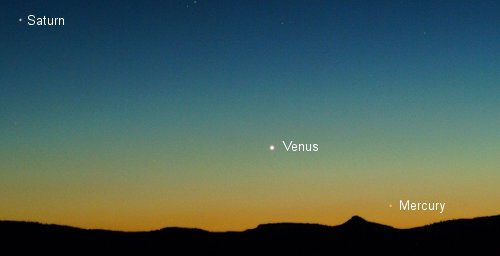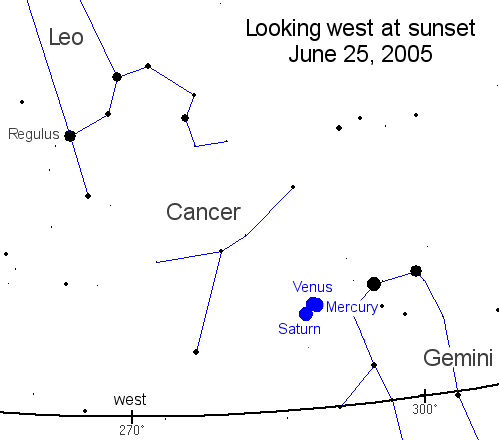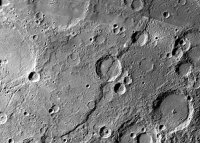|
Mercury, Venus and Saturn are converging
for a spectacular close encounter this weekend.
by Dr Tony Phillips
Stick up your thumb
and hold it at arm's length. It doesn't seem very big, does it?
But it is, big enough to hide three planets.
This weekend Mercury,
Venus and Saturn are going to crowd together in a patch of sky no
bigger than your thumb. Astronomers call it a "conjunction"
and it's going to be spectacular.
The show begins on
Saturday evening, June 25th. Step outside and look west toward the
glow of the setting sun. Venus appears first, a bright point of
light not far above the horizon. As the sky darkens, Saturn and
Mercury pop into view. The three planets form a eye-catching triangle
about 1.5o long, easily hidden by your thumb.

Image credit: Jimmy
Westlake of Yampa, Colorado.
Saturn,
Venus and Mercury converging at sunset on June 19, 2005.
The three planets will get much closer together in the
days ahead.
|
It gets better on Sunday
evening, June 26th. The triangle shrinks with Venus and Mercury
only 0.5o apart. Now they fit behind your pinky!
Monday evening, June
27th, is best of all. With Saturn nearby, Venus and Mercury converge.
At closest approach, the two planets will be less than one-tenth
of a degree apart. Such pairings of bright planets are literally
spellbinding.
If you go outside to
see the show, take someone along. Here are some fun facts you can
share:

The
western sky at sunset on Saturday, June 25th 2005
|
The closest planet
to the sun, Mercury, is not the hottest. Venus is. The surface temperature
of Venus is 870 F (740 K), hot enough to melt lead. The planet's
thick carbon dioxide atmosphere traps solar heat, leading to a runaway
greenhouse effect. On Venus, global warming has run amok.
Venus is so bright
because the planet's clouds are wonderful reflectors of sunlight.
Unlike clouds on Earth, which are made of water, clouds on Venus
are made of sulfuric acid. They float atop an atmosphere where the
pressure reaches 90 times the air pressure on Earth. If you went
to Venus, you'd be crushed, smothered, dissolved and melted - not
necessarily in that order. Don't go.
Mercury is only a little
better. At noontime, the surface temperature reaches 800 F (700
K). If you turn your kitchen's oven to that setting, the pizza will
burn to a smoking crisp. Radars on Earth have pinged Mercury and
found icy reflections near the planet's poles. How can ice exist
in such heat? NASA's MESSENGER spacecraft is en route to Mercury
now to investigate.

more
A
lobate scarp on Mercury, photographed by Mariner 10 in
1974.
|
Here's one way to trick
an astronomer: Show them a picture of Mercury and ask what it is.
Many will answer "the Moon," because the Moon and Mercury
look so much alike. But Mercury has something that the Moon does
not: long sinuous cliffs called "lobate scarps." Some
researchers think Mercury's scarps are like wrinkles in a raisin,
a sign of shrinkage. A shrinking planet? Weird.
If you look at Venus
or Mercury through a telescope, you won't be impressed. Both are
featureless, Venus because of its bland clouds, Mercury because
it is small and far away. Saturn is different. Even a small telescope
will show you Saturn's breathtaking rings.
Galileo Galilei discovered
Saturn's rings almost 400 years ago, but he didn't understand what
he saw. A planet with rings was too much even for Galileo. Scientists
today are still reeling. Saturn's rings are improbably thin. If
you made a 1-meter-wide scale model of Saturn, the rings would be
10,000 times thinner than a razor blade. They're full of strange
waves and spokes and grooves. And no one knows where they came from.
One school of thought
holds that Saturn's rings are debris from the breakup of a tiny
moon or asteroid only a few hundred million years ago. As recently
as the Age of Dinosaurs on Earth, Saturn might have been a naked
planet - no rings! Tiny moons orbiting among the rings today appear
to be stealing angular momentum, which, given time, could cause
the rings to collapse. Is Saturn like a flower, temporarily in bloom?

Photo credit: Cassini.
Saturn's
rings viewed edge-on.
|
That's one of many
questions being investigated by NASA's Cassini spacecraft, which
has been orbiting Saturn since 2004. Cassini is on a 4-year mission
to study Saturn's moons (all 34 of them), rings and weather. Every
day the craft beams stunning images to Earth: click
here to see them.
A lot can happen behind
your thumb. This weekend is a good time to look.
|
